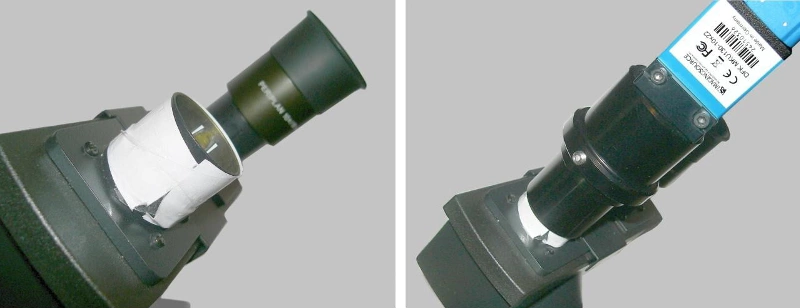Microscope Camera: Realization of a Universal Application
Published on August 17, 2016 by TIS Marketing.
Originally published in Mikroskopie in January 2016, this article was written by J. Piper and M. Torzewski. The English translation, written by Amy Groth, was serialized into: 1, 2, 3, 4, 5, 6, 7, 8, 9, 10 and 11.
Technical Realization of a Universal Application
The conspicuously small aperture on the front of the camera calls to mind a very tightly constricted human pupil and the aperture of a so-called pinhole camera. Behind this aperture, inside the camera, one finds a zoom lens system with autofocus. According to the manufacturer, in the zoom position 1x, the focal length of the lens system is 5.3 mm which corresponds to the small format image of 35 mm ( AOV: 64°). In combination with the relatively small sensor, this optical configuration (the very small entrance pupil and the short focal length) ensures a maximized depth of field. By loosening the Allen head screw, the included ocular can be adequately adjusted in the camera tube to ensure a vignette-free illumination of the imaged field of view and that the eyepoint of the ocular corresponds as precisely as possible with the exit pupil of the integrated optics; as a rule, pulling the eyepiece around 1 cm from its lowest position is sufficient.
When a microscope has a tube which fits with a 30 mm ocular, an eyepiece can simply be replaced with the manufacturer's included eyepiece and camera assembly. If the eyepiece diameter of the microscope is smaller, then the included eyepiece cannot be used. Nevertheless, in such cases a viable camera adaptation can usually be achieved. To this end, the included eyepiece must first be removed from the camera. The lens-less camera tube should now instead be connected to the microscope's original eyepiece or slipped over the microscope's eyepiece head. If necessary, a paper cuff can be placed around the microscope's eyepiece head so that the camera tube can be securely fitted without axial deviation or canting (see example in Fig. 3).

In cases where the eyepiece's outer diameter is larger than the inner diameter of the camera tube (33 mm), the camera tube will also need to be removed. In this case, the camera body as such can be placed (at a suitable distance respective to the exit pupil) directly on or over the microscope's eyepiece. If necessary, the end-user must make a mechanically suitable adapter themselves since the manufacturer only currently offers the aforementioned camera tube and eyepiece for glasses wearers.
In the case where a microscope with a trinocular port (C-Mount thread) is available, the included C-Mount adapter can be used. In so doing, the camera/tube/eyepiece combination can be docked directly onto the microscope's C-Mount port.
